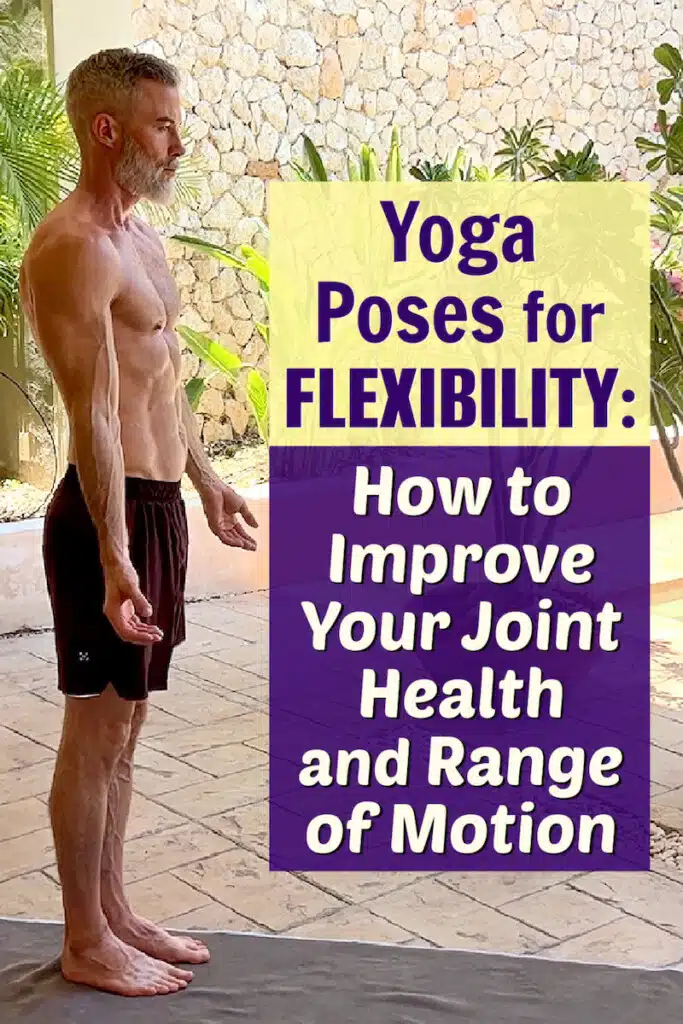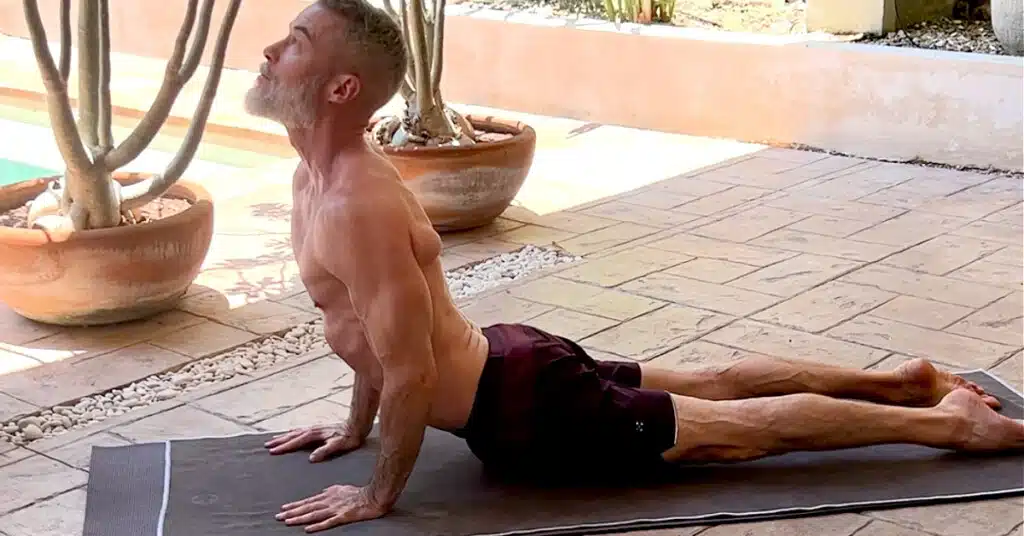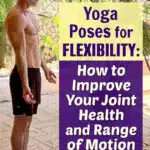Many people think of flexibility exercises as extra credit – a part of their workout that they might address once in a while when they feel they have the time to spare. Perhaps a few minutes of stretching tacked on to the beginning or end of their workout.
But, in reality, flexibility isn’t just an attribute – it’s the bedrock of your vitality.
Flexibility isn’t just a component of your physical wellness; it’s the secret ingredient that weaves through the tapestry of your body’s capabilities, adding a touch of grace and fluidity to every movement.
It keeps you healthy and injury-free.
It’s the foundation of your physicality.
Strong muscles, excellent posture, cardiopulmonary fitness, a youthful appearance, and robust overall health are all built upon your flexibility.
Flexibility improves your range of motion and enhances your functioning, helping you easily perform daily life – both routine and athletic tasks.
Flexibility keeps you young!
Below, I share some of the most helpful yoga poses for amplifying your flexibility.
These mobility movements will keep you youthful, not just at heart but in every bend and twist.
And, in case you’re the type of person who prefers motion to words, I’ve also included a video to guide you through each pose, ensuring your voyage into flexibility is not just informed, but inspired.
Flexibility Becomes More Important As You Get Older
The universe gives children the gift of inherent flexibility, but as you get older, flexibility has to be earned – it isn’t just given.
Without flexibility, you can’t squat properly, do dynamic shoulder movements, or stand up straight.
When your joints and muscles are supple and mobile, it makes proper alignment possible. The pelvis and spine sit properly inside a flexible body and create freedom of movement, which makes physique development possible.

Flexibility isn’t merely about being able to touch your toes or do a backbend. It’s about the overall health of your muscles, tendons, and joints, enabling your body to move easily and freely in every direction.
Incorporating yoga into your weekly fitness regimen can be a wise choice for improving flexibility. Yoga’s array of poses and stretches work wonders in enhancing your body’s suppleness. I know this from decades of experience, both for myself and my clients.
Unlock Vitality: Essential Yoga Poses for Enhanced Flexibility
Before I delve into the poses, it’s crucial for you to understand what flexibility really is.
Flexibility refers to the ability of your joints to move through their entire range of motion without restriction or discomfort.
A research study by Lorenzo Marcucci and Carlo Reggiani in 2020 focused on how muscles change as we age, particularly how they become stiffer even when we’re not moving them.
This muscle stiffness is not usually the first thing people think about when considering how aging affects muscles; often (we tend to think more about muscle strength or the ability to move quickly).
As people get older, muscles tend to get stiffer, making it harder to move freely and comfortably. This stiffness can affect daily activities, making it more challenging to perform tasks that were once easy.
For someone in midlife, understanding the potential personal impact of this can be crucial for several reasons – including awareness, prevention, healthcare, and treatment. The study’s results are significant because they shed light on a less-discussed aspect of aging that can significantly impact daily life, well-being, and the ability to stay active and independent as one gets older.
Yoga for Flexibility: Unlock Your Body’s True Potential • [Video]
Though flexibility varies among individuals and is influenced by gender and genetics, it’s most impacted by age and movement habits:
- an older person will typically have less flexibility than a younger person,
- and a sedentary person will typically have less flexibility than an active person.
“In our modern world, where most of us spend a significant amount of time sitting, the lack of movement and the prevalence of poor postural habits have led to a level of rigidity in the typical human body that is unprecedented. This rigidity not only predisposes us to injury but also significantly impairs our ability to perform basic functional movements, let alone athletic endeavors. Therefore, cultivating flexibility and mobility is not just beneficial; it’s a crucial element of maintaining our health and functionality in today’s world.”
–Kelly Starrett, physical therapist / author
Range of motion, closely tied to flexibility, is the full movement potential of a joint – usually its range of flexion and extension. For example:
- how high you can lift your arm,
- how deeply you can squat,
- or how fully your arms, legs, feet, or hands can move in a circular pattern within the ball and socket joints in your shoulders, hips, ankles, and wrists.
Regularly practicing yoga helps increase your range of motion by strengthening the muscles and ligaments surrounding your joints.
Yoga and Flexibility
Yoga is an ancient practice designed to unite mind, body, and spirit. While many appreciate its stress-relieving properties, yoga offers considerable physical benefits – like increased flexibility, improved posture, increased lung capacity, and enhanced balance and strength.
The yoga poses, known as “asanas,” involve stretching exercises that improve flexibility over time, especially when done consistently.
Ready to dive into some key yoga poses?
I encourage you to integrate these yoga poses for flexibility into your daily routine – or at least once a week – to develop your mobility.
I’ve included the Sanskrit names for these poses, too (Sanskrit is one of the world’s oldest – and arguably, most beautiful – languages and was probably the original language of yoga).
1. Downward Dog (Adho Mukha Svanasana)
Downward Dog is one of the most recognized yoga poses and an excellent stretch for your entire body. It’s particularly effective for your hamstrings, calves, shoulders, and even wrist and hand strength.
How to Do it: Start on your hands and knees. Keep your hands slightly ahead of your shoulders. Keep your knees directly below your hips. Then, exhale as you lift your knees off the floor, pushing your pelvis toward the ceiling:
- Aim to straighten your legs without locking your knees, creating an “A” shape with your body.
- Keep your body weight distributed up and back (keeping most of the load off your wrists).
By the way, downward dog is one reason participants don’t wear baggy t-shirts while doing yoga. The shirt will fall in your face, making it difficult to take deep breaths. Hence, the reason you see a lot of fitted microfiber athleisure wear being worn in most classes.
2. Cobra Pose (Bhujangasana)
Cobra pose stretches your shoulders, chest, and abdominal muscles. It’s also beneficial for improving spinal flexibility.

How to Do it: Lie flat on your stomach. Place your hands under your shoulders and keep your legs extended behind you. Press your palms into the floor as you slowly lift your upper body off the floor. Keep your gaze forward or slightly upward.
Press your shoulders down away from your ears. A common mistake I see is people doing cobra with their shoulders at their ears.
3. Standing Forward Bend (Uttanasana)
Uttanasana is a simple yet effective pose that stretches your hamstrings and calves while releasing tension in your spine.
How to Do it: Stand straight. Exhale as you bend from your hip joints, not from your waist. Place your palms or fingertips on the floor beside your feet if possible. If this is too challenging, cross your forearms and hold your elbows.
4. Seated Forward Bend (Paschimottanasana)
This seated pose gives your entire posterior chain – from your calves to your back – a good stretch.
How to Do it: Sit on the floor with your legs extended in front of you. As you exhale, lean forward from the hip joints, reaching towards your toes. If you can, hold your toes; otherwise, rest your hands wherever they reach on your legs.
Visualize your nose reaching out to your toes, this will help your spine to lengthen.
5. Pigeon Pose for Flexibility in Hips (Eka Pada Rajakapotasana)
Pigeon pose is a hip opener – it stretches hip rotators and flexors. It’s also good for relieving tension in the lower back.
How to Do it: Start in Downward Dog. Bring your right knee forward and place it behind your right wrist. Extend your left leg behind you, keeping your hips square to the floor. Depending on your flexibility, you can remain upright or fold forward, resting your forearms on the mat.
Tip: If your hip is too high off the floor, place a block or rolled-up towel underneath it for support. If your knee feels awkward or tender, try flexing your foot and repositioning the calf either closer or farther away. Sometimes you have to experiment with a pose – making nuanced micro adjustments – until you find the positioning that works uniquely best for you at that moment.
Note: Listening to your body as you practice these poses is crucial. Never force a pose that causes pain. Yoga is about gentle, progressive improvement, not about rushing to achieve the deepest possible bend.
Bonus Pose: Sleeping Hero (Supta Virasana)
I’ve included this one because, if you’re like me, your quadriceps also need a good stretch now and then.
However, I call it a “bonus” because it can be more of an intermediate-level stretch on account of how sensitive some peoples knees can be.
In this stretch, you simply begin in a kneeling position on your mat, then gradually lean back until you can use your forearms on the floor for support.
My tip for this one is not to just dump the weight of your body backward. It’s more active than that. You want to keep some energy in your glutes, as you scoop your pelvis forward and up a bit.
Think of this stretch as optional. If you’re having a good knee day, then by all means try it – just proceed cautiously.
Consistency and Patience are Key
Improving flexibility and range of motion isn’t an overnight process.
Improved mobility requires patience and consistent practice.
Aim to incorporate yoga into your routine at least 2-3 times weekly for noticeable improvements.
Warming up before these stretches and maintaining proper hydration can significantly boost your performance and results. I encourage everyone to consult their doctor before making any significant changes to their movement patterns.
Myth-Busting Yoga Poses
Let’s unravel the truth together and explore some lesser-known facts about key yoga poses.
Myths often circulate in the fitness world about the effectiveness of certain exercises to improve flexibility and range of motion. But, contrary to popular belief, some poses may surprise you with their impact on your body’s mobility.
You can embrace the genuine potential of yoga for enhanced flexibility by debunking these misconceptions:
“The Inversion Illusion” (Shirshasana – Headstand):
- Myth: Headstands are the ultimate key to flexibility.
- Truth: While headstands offer various benefits, flexibility primarily comes from consistent full-body stretches. Headstands emphasize balance and strength more than flexibility.
“Twist and Shout” (Ardha Matsyendrasana – Half Lord of the Fishes Pose):
- Myth: Twisting poses alone improve spine flexibility.
- Truth: Twists are beneficial, but focusing solely on them neglects other crucial muscle groups. Incorporate a variety of stretches for a comprehensive flexibility routine.
The Importance of Proprioception • “Mindful Movement Matters” (Vrksasana – Tree Pose):
- Explore the concept of proprioception – the body’s awareness of its position in space.
- Understand that yoga improves proprioception, enhancing your flexibility not just physically but also mentally.
Addressing Age-Related Flexibility Challenges • “You’re Never Too Old” (Virabhadrasana II – Warrior II):
- Challenge the notion that age hinders flexibility.
- Realize that there are individuals who, even in later years, have significantly improved flexibility through dedicated yoga practice. You can be among them!
Customizing Poses for Individual Needs • “One Size Doesn’t Fit All” (Balasana – Child’s Pose):
- Emphasize the importance of modifying poses based on individual body types and limitations.
- Adapt poses to accommodate your current fitness level and body condition.
Beyond Physical Flexibility • “Emotional Release in Pigeon Pose” (Eka Pada Rajakapotasana – Pigeon Pose):
- Explore how certain poses, like Pigeon Pose, can release emotional tension stored in the hips.
- There is a mind-body connection in yoga, and it’s absolutely true that emotional flexibility is intertwined with physical flexibility.
Encourage Exploration • “Beyond Asanas: The Yoga of Breath” (Pranayama):
- Introduce the significance of breath control (pranayama) in improving overall flexibility.
- Include simple breathing exercises that complement your physical poses and contribute to your holistic flexibility.
The Journey of Self-Discovery • “Flexibility as a Metaphor” (Savasana – Corpse Pose):
- Use Savasana as a metaphor for the importance of rest in the journey to flexibility.
- Allowing your body and mind to rest is a crucial part of enhancing your overall flexibility.
Engaging in Guided Practice
For beginners, it’s advisable to start yoga under the guidance of a trained instructor. A good coach can ensure you’re performing poses correctly, minimizing the risk of injury. Local gyms often offer yoga classes, or you could explore online platforms that provide detailed video guidance.
Unleash Your Range of Motion: Conclusion on Flexibility Yoga Poses
Imagine muscles that don’t just boast of strength but whisper tales of untold flexibility, posture that doesn’t just stand but soars, a heart and lungs that don’t just pump but dance in rhythm.
With flexibility, your body moves in poetry, each motion a stanza that speaks of enhanced range, reduced injury risks, and an effortless fusion of routine and athletic prowess. It’s not just about touching your toes; it’s about reaching for the stars with every fiber of your being.
Yoga offers a more holistic approach to improving flexibility.
Not only does yoga enhance your physical flexibility, but it also cultivates mental flexibility, resilience, and the ability to stay present.
With its myriad poses catering to different skill levels, yoga invites everyone to participate, regardless of their current flexibility or fitness level.
So unroll your yoga mat and embark on a journey towards a more flexible you. Remember, the goal isn’t just to touch your toes but to journey inward, exploring what your body can do and nurturing your connection with yourself.
Whether you’re an experienced yogi or an absolute beginner, integrating the above yoga poses for flexibility can significantly affect your body’s mobility, strength, and overall well-being.
Embrace yoga not just as an exercise but as a lifestyle, and witness your flexibility, and life, transform beautifully.
